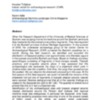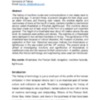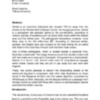2017 Session 5: Iran’s Maritime Cultural Landscape
Dublin Core
Title
2017 Session 5: Iran’s Maritime Cultural Landscape
Description
The country of Iran benefits from having a long coastline. Sea spaces and coastlines were attractive settlements for humans throughout history. These extensive maritime landscapes have resulted in interactions between human and sea along the northern (Caspian Sea) and southern (Persian Gulf and Sea of Oman) coastlines of Iran. Iran’s rivers and lakes contain a great deal of evidence of human habitation and interaction. Due to the country’s long history of maritime culture, we can also observe sea effects on coastal communities in Iran. Maritime archaeological studies in Iran, however, are at a nascent stage.
In the 1990’s, a small group of archaeologists from the Iranian Center for Archaeological Research (ICAR) investigated in the north of Persian Gulf to decode its unknown history. In 2000, the first coherent and planned activities of that group produced the "Underwater Surveys around the shores of Siraf Port in Bushehr Province". After that, the team surveyed "Bandar-e Rig"(Rig port), Portuguese castles in Siraf port, Southern Shores of the Bushehr Peninsula in the Persian Gulf. The team has worked on sites from "Shushtar’s Band-e Mizan"(Shushtar barrier), "Takht-e Suleiman" Lake, and the Amir Abad and "Zaghmarz" shipwrecks; the "TammÄ«sheh and GorgÄn" Underwater Walls, and the "Ghorogh" and "Rudsar" shipwrecks. These projects were published in Persian by a domestic magazine. The team then prepared and distributed a booklet titled of "Iran, Underwater Cultural Heritage and It's Share in Maritime Archeological Studies" for the annual meeting of States Parties of The UNESCO Convention on the Protection of the Underwater Cultural Heritage in 2016. Next, UNESCO and ICHTO held "Training Workshop on Underwater Archaeology with a Focus on the UNESCO 2001 Convention" in Iran. These activities are continuing and we hope for some continued progress in maritime archaeological studies and international cooperation.
In the 1990’s, a small group of archaeologists from the Iranian Center for Archaeological Research (ICAR) investigated in the north of Persian Gulf to decode its unknown history. In 2000, the first coherent and planned activities of that group produced the "Underwater Surveys around the shores of Siraf Port in Bushehr Province". After that, the team surveyed "Bandar-e Rig"(Rig port), Portuguese castles in Siraf port, Southern Shores of the Bushehr Peninsula in the Persian Gulf. The team has worked on sites from "Shushtar’s Band-e Mizan"(Shushtar barrier), "Takht-e Suleiman" Lake, and the Amir Abad and "Zaghmarz" shipwrecks; the "TammÄ«sheh and GorgÄn" Underwater Walls, and the "Ghorogh" and "Rudsar" shipwrecks. These projects were published in Persian by a domestic magazine. The team then prepared and distributed a booklet titled of "Iran, Underwater Cultural Heritage and It's Share in Maritime Archeological Studies" for the annual meeting of States Parties of The UNESCO Convention on the Protection of the Underwater Cultural Heritage in 2016. Next, UNESCO and ICHTO held "Training Workshop on Underwater Archaeology with a Focus on the UNESCO 2001 Convention" in Iran. These activities are continuing and we hope for some continued progress in maritime archaeological studies and international cooperation.
Creator
Hossien Tofighian
Research Institute of Cultural Heritage & Tourism (RICHT), Iran
Research Institute of Cultural Heritage & Tourism (RICHT), Iran
Ramin Adibi
Higher Institute of Marlik University, Iran
Higher Institute of Marlik University, Iran
Collection Items
Underwater Archeological investigation of Bushehr coastlines in Persian Gulf
When the Research Department of the University of Medical Sciences of Bushehr was studying marine biomedicine around the Bushehr peninsula they inadvertently discovered some pottery fragments. They then reported it to the Bushehr province Cultural…
An Introduction to the Maritime Construct of Khashabat in the Persian Gulf
The history of maritime routes and communications in Iran dates back to a long time ago. In ancient times, to prevent dangers for their ships such as water thinness and thawing near coasts, the shallow depths and narrowness of rivers at the mouth of…
A survey on a petroglyph illustrating a watercraft at the hinterland site of Dehtal
Dehtal is an important hinterland site, located 170 km away from the shores of the Persian Gulf in Bastak County, Hormozgan province. Dehtal is a petroglyph site possibly dating to the pre-Neolithic, according to various sources of evidence such as…
Boat and ship Archaeology in Gilan Province (Iran)
Gilan province is one the northern states of Iran which is located in south west of Caspian Sea and has relatively long coastlines. According to historical and geographical location of Gilan, in 2017, Maritime archaeology group of Iranian Center for…
Collection Tree
- Proceedings of the 2017 Asia-Pacific Regional Conference on Underwater Cultural Heritage
- 2017 Session 5: Iran’s Maritime Cultural Landscape



